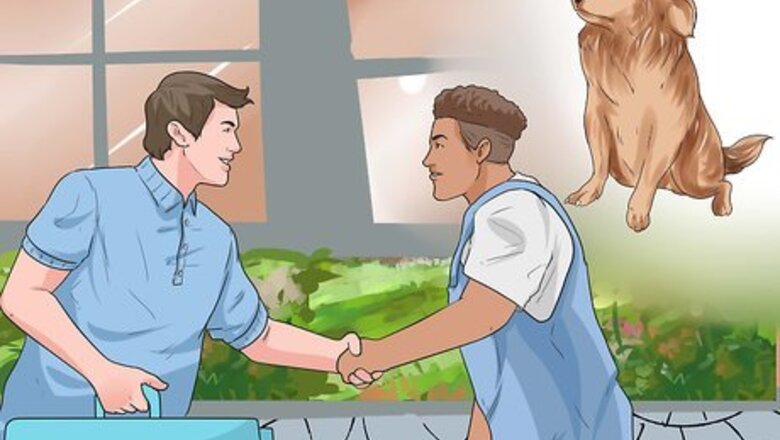
views
Determining if You Should Breed Your Chihuahua
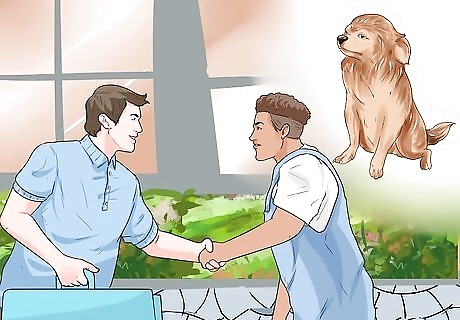
Adopt a Chihuahua to breed. If you don't already have a Chihuahua, you will need to get one that is ideal for breeding. Contact a breeder that specializes in breeding Chihuahuas. If you are looking to adopt a Chihuahua you can breed, you should get it from a well-established and humane breeder that has solid documentation of its lineage. Make sure your potential dog is in good physical and mental shape. This means it needs to adhere to the breed standards for size and shape, as well as being well tempered and social. Contact your local Chihuahua clubs, as well as national organizations, for a list of breeders that use good breeding stock and have a good track record. Make sure to go only to a respectable breeder. Good breeders will allow you to visit them, have happy and healthy looking dogs and puppies, have a lot of room for the dogs to roam, have a specialty breed they specialize in, and will show concern and interest in how you will care for and raise their dogs. When you are interacting with a well-regarded breeder, pay attention to how the person conducts business and how he or she interacts with the dogs. You can learn a lot just from watching how a professional conducts business. The Humane Society has a good checklist to use when assessing a breeder. In some cases you can pay to hire a stud, a male dog that is hired out to impregnate female dogs. This means that you may only need to adopt one dog, most likely the female.
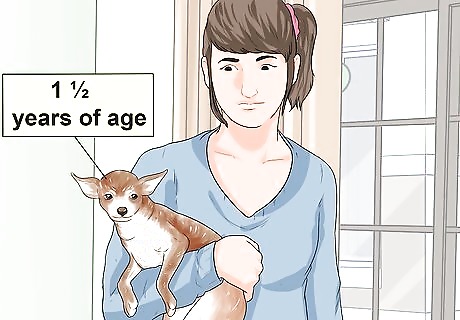
Assess whether your Chihuahua is old enough to breed. You need to figure out if it is ready and capable of reproduction. A female Chihuahua should not be used for breeding until she weighs at least 4 pounds and she has had a few heat cycles, as she will not be physically mature enough to handle a pregnancy until after that age. A male Chihuahua will generally have viable sperm when he is over a year of age but he is at his prime breeding age from 1 ½ to 5 years of age.

Figure out if your dog has good physical traits for breeding. Does your dog have desirable breed traits? Does it meet breed standard minimums? According to the Chihuahua Club of America, the Chihuahua should be a “compact little dog with terrier-like qualities of temperament” and should be a “well-proportioned little dog not to exceed six pounds.” The head should be “a well-rounded “apple dome” skull” with “full, round” eyes “but not protruding.” The ears are “large, erect type ears, held more upright when alert, but flaring to the sides at a 45 degree angle when in repose.”

Assess whether your dog has physical problems that could be passed on to offspring. Does the dog have any abnormalities that may be passed along to its offspring? Many defects, such as a mismatched jaw, can be heritable traits.The Chihuahua breed is also prone to a few serious health problems. Dogs with these problems should not be used for breeding, as their offspring have a higher likelihood of developing these problems. These include: Collapsing trachea Luxating patellas (kneecaps) Hydrocephalus (water on the brain) Atlantoaxial instability (neck instability) Dental problems, including deformed teeth or jaw problems. Their small mouths can mean dental problems that wouldn’t cause an issue in larger dogs.
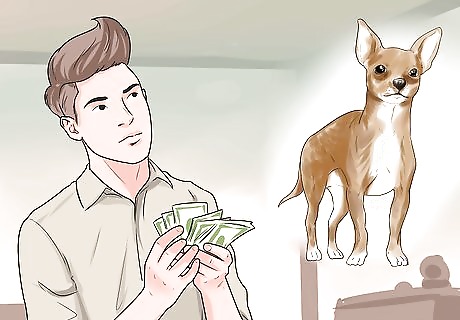
Consider whether you have the financial ability to breed your dog. Do you have the financial resources to pay for any potential complications during the pregnancy and delivery and with the puppies? Things to consider are the possibility of an emergency Cesarean section surgery and the mother becoming potentially deathly ill with pregnancy related conditions like hypocalcemia, metritis, or mastitis. Is there a market in your area to sell the puppies? Marketing starts well before the puppies are born. Contact local dog clubs to connect with potential buyers. Are you prepared to keep any unsold puppies and raise them alongside the parents? Sometimes it can be hard to sell all the puppies in a litter.

Assess whether you have the time to devote to breeding your dog. Do you have the time to devote to the proper care of your dog and the puppies, including daily handling of the puppies to properly socialize them to humans? Puppies that are handled daily are used to humans and make good pets. Puppies that don’t have much interaction with humans or who are handled roughly by humans can be fearful of humans and don’t make good pets.
Breeding Chihuahuas

Understand the reproductive system of the male Chihuahua. The visible parts of the male Chihuahua’s reproductive system are the penis and the scrotum. The scrotum is a pouch of skin outside the abdomen that holds the testicles outside the belly. The testes produce the sperm, which fertilize the egg. The testes also produce the male sex hormones, including testosterone which gives the male dog its sex characteristics. There are normally two testes, which descend into the scrotum during puberty. They are located outside the abdomen as body temperature is too warm for sperm to develop normally. Therefore, dogs with undescended testes or only one testes do not make good candidates to breed. These dogs should be neutered, as a testicle retained inside the abdomen can cause health problems later in life. A responsible breeder won’t breed a male dog with this problem, as it can be passed onto its offspring and perpetuate health issues.

Understand the reproductive system of the female Chihuahua. For the most part, the female Chihuahua’s reproductive system is located inside the abdomen. The only visible part is the vulva. The ovaries are the female gonads, which produce eggs and the female sex hormones such as estrogen and progesterone. After eggs are fertilized by sperm they latch onto the uterus’ lining and develop into puppies. When the puppies are ready to be birthed, the cervix opens and the puppies are pushed out through the vagina and out the vulva.
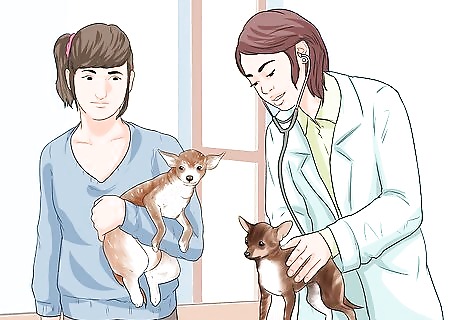
Have both dogs evaluated by a veterinarian. Before you breed your Chihuahua it should have a thorough veterinary examination about one month prior to breeding. This is to make sure the female is healthy enough to carry a litter of puppies or that the male is free from any defect or disease.

Watch for signs that the female is in heat (when she is ready to mate). Because you waited for 2 years before breeding your female Chihuahua, you should have an idea of the next time she will come into heat. A female generally comes into heat twice a year, however each dog is different. During the start of the heat cycle there is a preparatory stage, proestrus, when the female’s vulva swells and she has a light bloody discharge for 7-9 days, although this will vary. After this stage the bleeding slows and the female becomes receptive to breeding. This is estrus, also called standing heat. The most fertile time for breeding will be at the end or just after standing heat occurs. Your Chihuahua’s veterinarian can determine the stage of heat the female dog is in through swabbing the inside the vagina with a cotton swab and then examining the cells under a microscope. This will help you time the breeding with the male. A serum progesterone test using a sample of blood to measure hormone progesterone levels in the blood can also help to determine ovulation time.

Put the male and female in the same room and allow them to mate. When the female is receptive to breeding she will act interested in the male by bowing to him and backing into him. The male will usually reciprocate this interest and mount her for breeding. As long as the dogs are in a quiet place no help is usually needed with this process. During the dog mating process, part the male dog’s penis will swell while it is in the female’s vagina which also swells. This is what is called a tie, where the penis is “trapped” inside the female. This lasts for around 10 minutes and is a desirable sign of a successful mating, although a pregnancy can also occur without a tie.

Mate the dogs several times for the best chances of getting the female pregnant. Many breeders will mate the dogs every other day, for a total of 2-3 times, to assure the best chance of a pregnancy. After a successful mating the female Chihuahua’s body will prepare her pregnancy which lasts on average around 63 days.



















Comments
0 comment